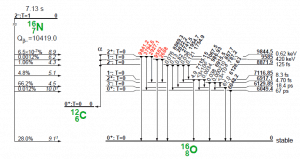In nuclear reactors, the thermal power produced by nuclear fissions is proportional to the neutron flux level. Therefore, from the reactor safety point of view, it is of the highest importance to measure and control the neutron flux and the spatial distribution of the neutron flux in the reactor correctly and by appropriate instrumentation. For this purpose, various nuclear instrumentations are installed. These measurements are usually performed outside the reactor core, but there are also measurements performed from inside the core. Therefore, nuclear instrumentations are usually categorized as:

Both systems are based on the detection of neutrons. But there are power plants that measure the thermal power using nitrogen-16 power monitoring. An N-16 power monitoring has several advantages over the ΔT and excore power measurements. The system based on this method monitors the thermal power of the NSSS (Nuclear Steam Supply System) by detecting the level of nitrogen-16 present in the coolant system. Nitrogen-16 is an isotope of nitrogen generated by neutron activation of oxygen contained in the water. It has a short half-life of 7.1 sec and decays via beta decay. This decay is accompanied by the emission of very energetic gamma rays (6 MeV), which can readily penetrate the wall of the high-pressure piping and can therefore be easily measured by ion chambers located on the hot leg piping of each coolant loop.
1n + 16O → 1p + 16N (activation reaction)
16N → 16O + β + γ (radioactive decay)
Isotopes of nitrogen-16 are formed by fast neutron activation of oxygen-16 contained in the water. Activation results from a threshold reaction requiring >10 MeV fast neutrons. The concentration of nitrogen-16 present in the primary coolant is in radioactive equilibrium, and it is directly proportional to the fission rate in the core, thus to the reactor power. This activation of the coolant water requires extra biological shielding around the nuclear reactor plant. The high-energy gamma-ray from nitrogen-16 causes major concern. This is why water that has recently been inside a nuclear reactor core must be shielded until this radiation subsides. One to two minutes is generally sufficient.
Similarly, as for the excore nuclear instrumentation system, this N-16 monitoring system must be calibrated. The accurate thermal power of the reactor can be measured only by methods based on the energy balance of the primary circuit or the energy balance of the secondary circuit. These methods provide the most accurate reactor power.